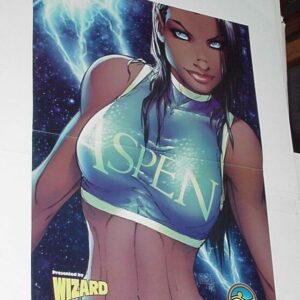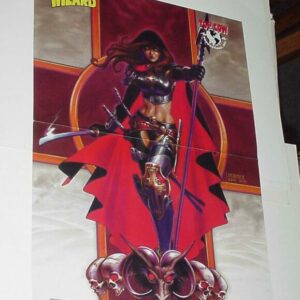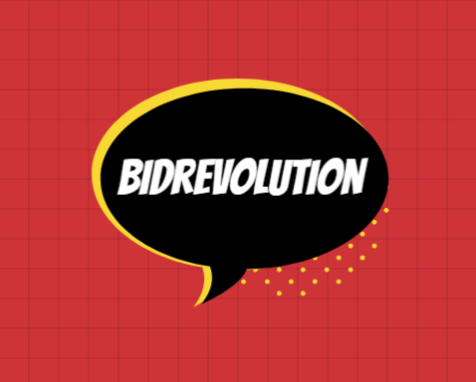Aliens Poster #53 FRAMED Alien about to strike Arthur Suydam Marvel Zombies
$99.99
Description
The “Alien” (sometimes referred to as a “Xenomorph”) is a endoparasitoid extraterrestrial species that is the primary antagonist of the Alien film series. The species made its debut in the film Alien (1979), and reappeared in the sequels Aliens (1986), Alien 3 (1992), and Alien Resurrection (1997), as well as the crossover franchise Alien vs. Predator (2004) and Aliens vs. Predator: Requiem (2007). A similar creature of a slightly different design also briefly appears in the Ridley Scott film Prometheus (2012). In addition, the Alien appears in various literature and video game spin-offs from the franchises. Unlike many other recurring enemy extraterrestrial races in science fiction, the Aliens do not have a technological civilization, but are predatory creatures with no higher goals than the propagation of their species and the destruction of life that could pose a threat (the film Prometheus implies they were engineered as a biological weapon by an advanced race). Like wasps or termites, Aliens are eusocial, with a single fertile queen breeding a caste of warriors. The Aliens’ biological life cycle involves traumatic implantation of parasitic larvae inside living hosts, which mature before erupting from the host’s chest. Their design deliberately evokes many sexual images, both male and female, to illustrate their blurring/reversal of human sexual dichotomy.
The Alien design is credited to Swiss surrealist and artist H. R. Giger, originating in a lithograph called Necronom IV and refined for the series’ first film, Alien. The species’ design and life cycle have been extensively added to throughout each film. The script for the 1979 film Alien was initially drafted by Dan O’Bannon and Ronald Shusett. Dan O’Bannon drafted an opening in which the crew of a mining ship are sent to investigate a mysterious message on an alien planet. He eventually settled on the threat being an alien creature; however, he could not conceive of an interesting way for it to get onto the ship. Inspired after waking from a dream, Shusett said, “I have an idea: the monster screws one of them,” planting its egg in his body, and then bursting out of his chest. Both realized the idea had never been done before, and it subsequently became the core of the film. “This is a movie about alien interspecies rape,” O’Bannon said on the documentary Alien Evolution, “That’s scary because it hits all of our buttons.” O’Bannon felt that the symbolism of “homosexual oral rape” was an effective means of discomforting male viewers. Swiss surrealist artist H. R. Giger. Giger showed O’Bannon his nightmarish, monochromatic artwork, which left O’Bannon deeply disturbed. “I had never seen anything that was quite as horrible and at the same time as beautiful as his work,” he remembered later. He suggested to director Ridley Scott that he be brought on to design the Alien, saying that if he were to design a monster, it would be truly original. After O’Bannon handed him a copy of Giger’s book Necronomicon, Scott immediately saw the potential for Giger’s designs, and chose Necronom IV, a print Giger completed in 1976, as the basis for the Alien’s design, citing its beauty and strong sexual overtones. That the creature could just as easily have been male or female was also a strong factor in the decision to use it. “It could just as easily fuck you before it killed you”, said line producer Ivor Powell, “which made it all the more disconcerting.” Fox studios were initially wary of allowing Giger onto the project, saying that his works would be too disturbing for audiences, but eventually relented.
Giger conceived the Alien as being vaguely human but a human in full armor, protected from all outside forces. He mandated that the creature have no eyes, because he felt that it made them much more frightening if you could not tell they were looking at you. Giger also gave the Alien’s mouth a second inner set of pharyngeal jaws located at the tip of a long, tongue-like proboscis which could extend rapidly for use as a weapon. His design for the creature was heavily influenced by an aesthetic he had created and termed biomechanical, a fusion of the organic and the mechanic. His mock-up of the Alien was created using parts from an old Rolls Royce car, rib bones and the vertebrae from a snake, molded with plasticine. The Alien’s animatronic head, which contained 900 moving parts, was designed and constructed by special effects designer Carlo Rambaldi. Giger and Rambaldi would both go on to win the 1980 Academy Award for Visual Effects for their design of the Alien.
Scott decided on the man-in-suit approach for creating the creature onscreen. Initially circus performers were tried, then multiple actors together in the same costume, but neither proved scary. Deciding that the creature would be scarier the closer it appeared to a human, Scott decided that a single, very tall, very thin man be used. Giger’s design for the Alien evoked many contradictory sexual images. As critic Ximena Gallardo notes, the creature’s combination of sexually evocative physical and behavioral characteristics creates, “a nightmare vision of sex and death. It subdues and opens the male body to make it pregnant, and then explodes it in birth. In its adult form, the alien strikes its victims with a rigid phallic tongue that breaks through skin and bone. More than a phallus, however, the retractable tongue has its own set of snapping, metallic teeth that connects it to the castrating vagina dentata.”
Alien blood is an extremely potent acid and is capable of corroding on contact almost any substance with alarming speed. It is dull yellowish-green in color, and seems to be pressurized inside the body so that it spurts out when punctured. Ron Cobb suggested the idea that the creature have acid blood as a plausible means to make the creature “unkillable”; if one were to use traditional firearms or explosives to attack it, its blood would eat through the hull of the ship.
Aliens are eusocial life-forms with a caste system ruled over by a queen. Their life cycle comprises several distinct stages: they begin their lives as an egg, which hatches a parasitoid larval form known as a facehugger, which then attaches itself to a living host by, as its name suggests, latching onto its face. In the Alien 3 novelization, Ripley commented that this parasitoid would likely be able to use a host as small as a cat, or as large as an elephant. The facehugger then “impregnates” the host with an embryo known as a “chestburster”, which, after a period of gestation, erupts violently from the host’s chest resulting in the death of the host. The chestburster then matures to an adult phase, shedding its skin and replacing its cells with polarized silicon. Due to horizontal gene transfer during the gestation period, the Alien also takes on some of the basic physical attributes of the host from which it was born, allowing the individual alien to adapt to the host’s environment. The adult phase of the Alien is known by various different names. The adult Aliens have been referred to as “drones,” “warriors,” “workers,” and sometimes “soldiers,” similar to the way ants have been defined.
Arthur Suydam (born 1953) is an American comic book artist and musician. He has done artwork for magazines including Heavy Metal, Epic Illustrated and National Lampoon, while his comic book work includes Batman, Conan, Tarzan, Predator, Aliens, Death Dealer, and Marvel Zombies. Arthur Suydam’s comic book work includes such titles as Batman, Conan, Tarzan, Predator, Aliens and Death Dealer. Recently, his work has primarily been on covers, including Marvel Zombies, Ghost Rider, Hellstorm, Moon Knight, Wolverine, Marvel Zombies vs. The Army of Darkness, and Raise the Dead. Suydam is also a singer-songwriter of American roots music, who plays in the band, the Gotham Playboys. He has performed with Bill Haley’s Comets and The Platters. He has also composed and recorded the soundtrack to the independent film, The Feud. Suydam was friends with the late legendary fantasy painter Frank Frazetta and considers him a mentor.
This image is printed on glossy card stock.
Frame is shrinkwrapped until time of purchase. Ships boxed with packing peanuts.
THE PERFECT GIFT!
Related products
-


Fathom Poster # 9 Aspen Shirt Michael Turner Matthews Superman
$39.99 Add to cart -


Magdelena Poster Joe Michael Linsner Dawn
$34.99 Add to cart -


Daredevil vs Elektra Poster Ultimate Salvador Larroca
$29.99 Add to cart -


Supreme Power Poster # 1 Joe Quesada Hyperion Doctor Spectrum Squadron
$29.99 Add to cart






